Research to Practice, Practice to Research
Facilitating Learner-Centered Interactions Through Applied Improvisation
Connected Science Learning May-June 2022 (Volume 4, Issue 3)
By Ron Skinner, Danielle Harlow, Dan Gunther, Kaia Joye Wesolowski, Jasmine Marckwordt, and Alexandria Muller
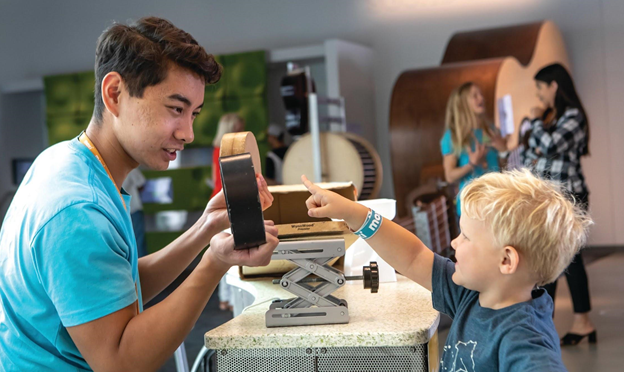
Learner-centered interactions, whether in formal or informal settings, are by their nature unscripted and require both the educator and learner to improvise. In fact, improvisation skills have been recognized as beneficial and applied in a variety of professional development training programs (including science communication, organizational development in university administration, teambuilding and leadership in business, and communication skills in medical education); yet, their inclusion in educator training has been limited (Bernstein 2014; Rossing and Hoffmann‐Longtin 2016; Oleniczak 2016).
A Learner-Centered Facilitation Training Program
As a new interactive science museum with a vision of visitor-centered learning, MOXI, The Wolf Museum of Exploration + Innovation in Santa Barbara, California, was challenged to develop educators’ capacity to engage museum visitors in STEM practices in a way that would be responsive to visitors' ideas. To this end, MOXI collaborated with the University of California, Santa Barbara (UCSB) to create a staff training model that equips informal educators with the skills they need to engage a broad and diverse museum audience in using STEM practices (Harlow and Skinner 2019; Skinner et al. 2019). These skills include the ability to listen carefully to museum visitors and observe their gestures, expressions, and body language; use these observations to assess how visitors are engaging with an exhibit; and make choices about how to facilitate a learner-centered interaction. These are challenging skills to develop, especially for new informal educators receiving minimal training.
Following the lead of Oleniczak (2016), MOXI and UCSB partnered with a professional actor and theater instructor (third author of this paper) to implement applied improvisation training to support informal educators' skills development. After four years of incorporating applied improvisation training in our facilitation training program, we have found that the basic skills of listening, observing, and responding that are critical in learner-centered education are taught effectively through the well-developed, practical, and fun exercises of improvisational theater.
In this article, we describe our applied improvisation training and how it builds skills pertinent to implementing learner-centered facilitation, how graduates of our training program connected applied improvisation training to their facilitation, and how other institutions can incorporate it into preparing educators for working in either informal or formal settings.
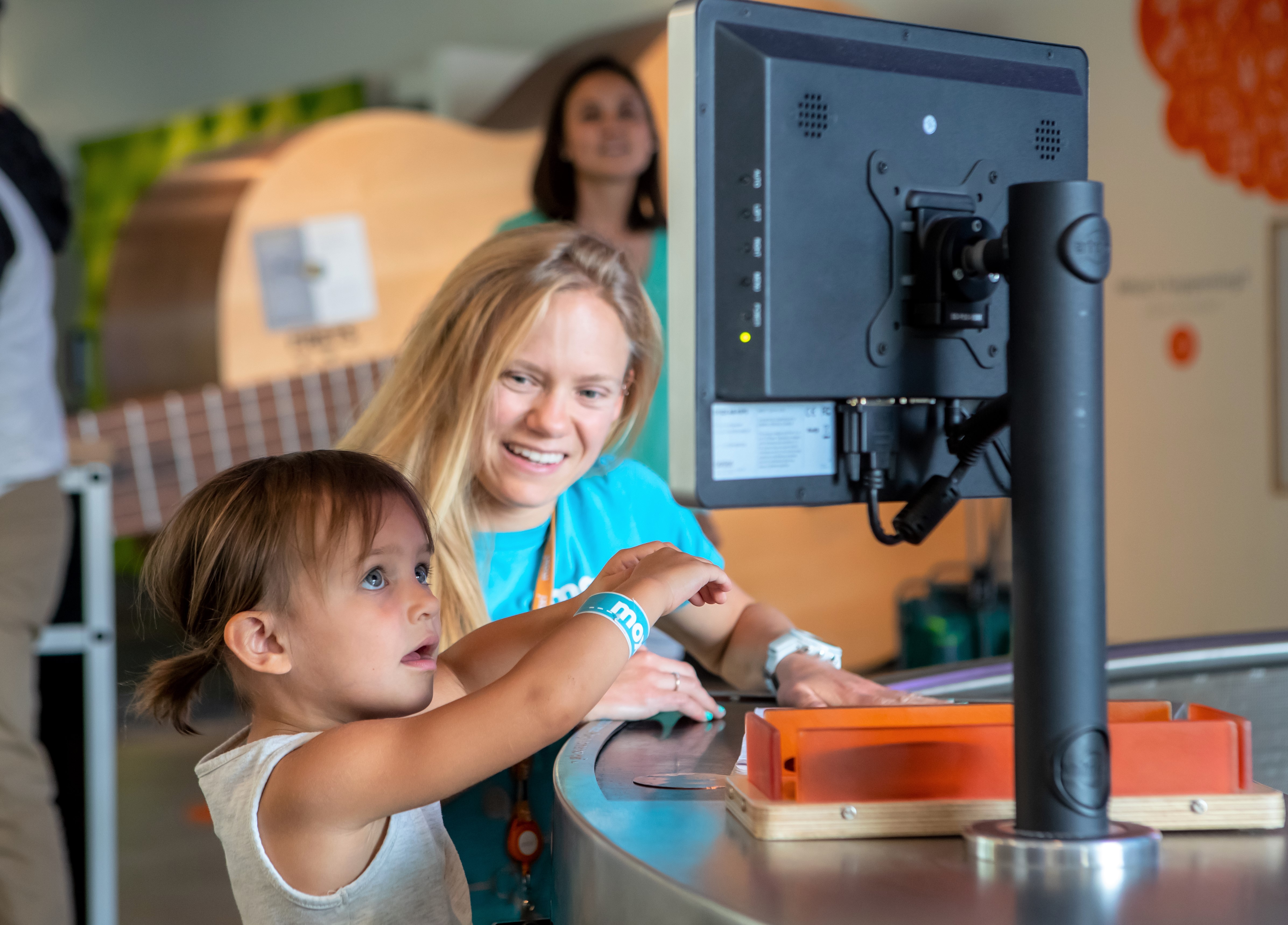
Applied Improvisation Training
Applied improvisation training consists of fun, playful exercises in group listening and communication. As participants (referred to as “players”) practice these simple exercises, they develop skills that help them grow as flexible and responsive educators. We selected examples of exercises (“games”) to focus on the following improvisation skills: Overcoming fear of failure, focus and presence in an unpredictable environment, creative spontaneity, spontaneous storytelling, and accepting offers with the whole body.
Overcoming fear of failure
Fear of failure (saying the wrong thing, not knowing an answer, being uncomfortable, stumbling over words) comes from a lifetime of learning to avoid failure and can inhibit educators from engaging in unscripted interactions with learners. The first lesson of our applied improvisation training is that making mistakes is a part of the process. Whenever a player makes a mistake during applied improvisation games, they are instructed to throw both arms over their head and exclaim, “Woo Hoo!” The rest of the players respond with acceptance, cheering, and applause.
Focus and presence in an unpredictable environment
The training begins with simple games played standing in a circle, such as Whoosh, Bang, Pow. In this game, a two-handed gesture is passed from one player to their neighbor around the circle. Complexity increases as players are given two or three choices of gestures to pass. Some of these added gestures change the direction of the gesture’s movement or move the gesture across the circle changing the order of players from predictable to random. This unpredictability requires players to engage in highly focused active observing and listening, skills that also improve educators’ learner-centered facilitation.
Other games build on that increased focus and attention. For example, in one game, players move about the room while observing each other’s movements. One player is selected to set a style of whole-body movement, such as pretending to walk on a tightrope. All players mirror this until another player is tapped by the originator of the movement to change the style of movement. Players must observe the change and imitate the new style all while moving about the room randomly. In a variation, all players must stop moving at the same time with no cue to do so. Players begin to watch and listen with a new level of focus and presence.
Creative spontaneity
As players become more comfortable with these motions and games, their fear of failure recedes. The instructor adds exercises that include small amounts of creativity, such as one player setting a scene and adding to that scene player by player. In the game I am a Tree (see Figure 1), a player takes the stage at the center of the circle and begins with the title statement, “I am a Tree.” Other players enter the circle one at a time and creatively add to the scene: “I am a nest"; "I am a bird bringing sticks to build the nest." The next scene begins by removing two of the players, leaving just one of the three players (e.g., “I am a bird bringing sticks to build a nest”). New players add to the new scene: “I am a potential mate doing a courtship display”; "I am a snake waiting for baby birds.” Players begin to improvise, making further creative leaps easier and more cohesive, leading to actual storytelling.
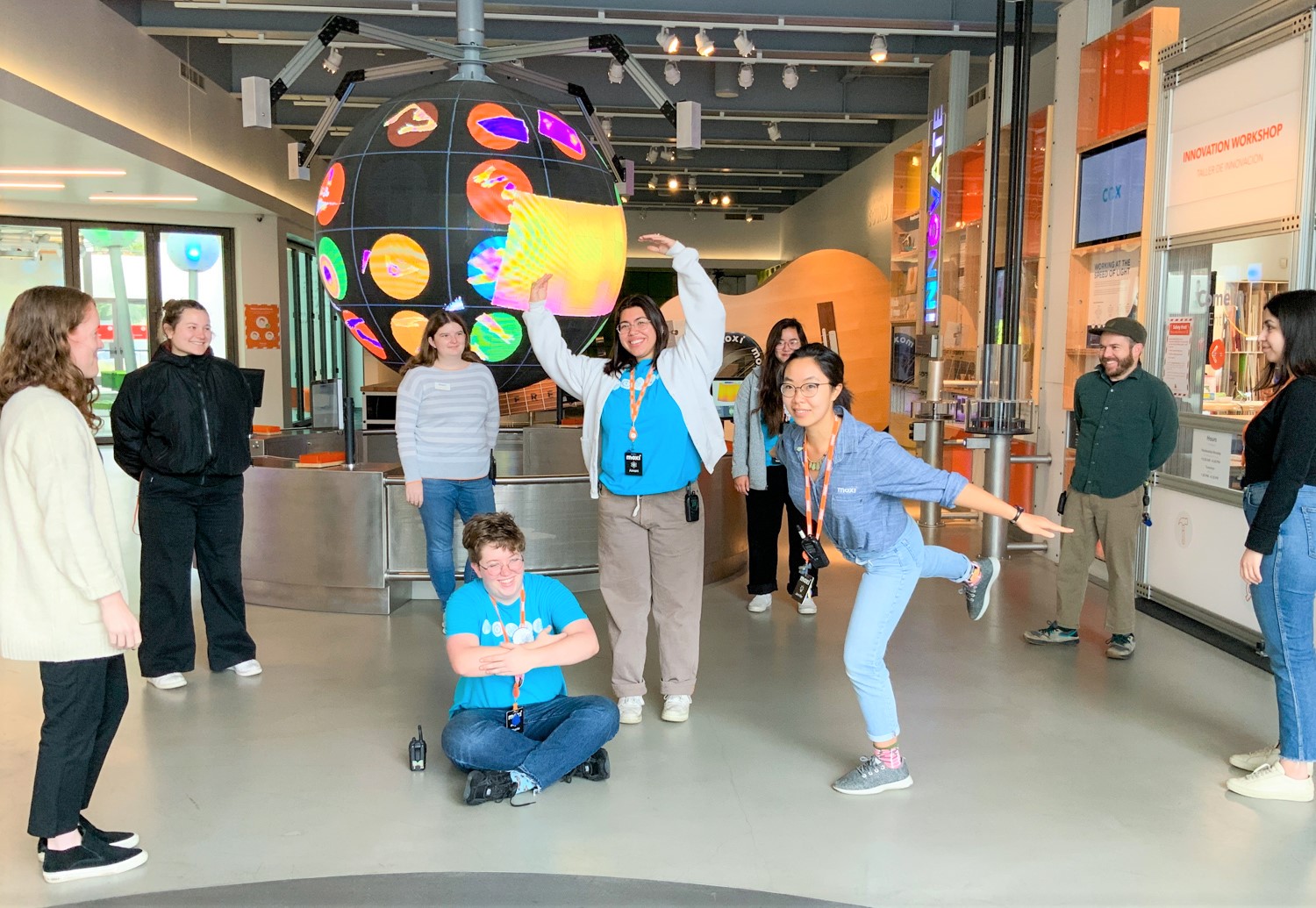
Spontaneous storytelling
Several games teach storytelling basics in a way that nurtures emerging creativity, with players working in small groups. An example is Word at a Time Story, where a group of three players tell a story to the whole group, but each takes a turn contributing a single word at a time. The story is built collaboratively, and no player can pre-plan their contribution because they do not know what their cue word will be. Moving educators away from pre-planned responses and towards spontaneous contributions to a collaborative story is an important step in developing the disciplined improvisation that Sawyer (2011) associates with good, creative teaching.
Accepting offers using the whole body
As players begin to share and collaborate, more complex improvisation principles are introduced. For example, in a circle game called Giving Gifts, one player hands their neighbor an imaginary box, using gestures and body movement to indicate a size and weight of the box. The receiver must open the box, and as they say, "thank you," they name the gift they imagine inside of the box (e.g., "A puppy!"). This game is enhanced by presenting the gift with a bit of information: “I got you this for our anniversary!” or “Congrats on your promotion!” This sort of information tidbit (where, when, who, what) is one example of what improvisers call “making an offer.”
The ability to make and accept offers is perhaps the most vital skill set among good improvisers. This type of play is unpredictable and requires players to respond organically to ideas and not pre-plan responses. These games exemplify improv’s “YES, AND” philosophy of accepting offers and adding to them. Practicing the skill of adding to the offers of others develops educators’ abilities to respond to and build upon learners’ ideas and questions. Applied improvisation players learn quickly that a series of "YESes" will always go somewhere and feel inclusive, but a single “NO” can be a dead end. Saying "YES, BUT" is just another way of saying “NO,” shutting down the conversation and introducing a sense of right and wrong. See Table 1 for an example of two conversations (actual and hypothetical) between an informal educator and a 4th-grade student that show the differences between “YES, AND” and “YES, BUT” in a museum context. In these examples the learner is engaged with an exhibit in which they build a bridge between two strong magnets using steel washers.
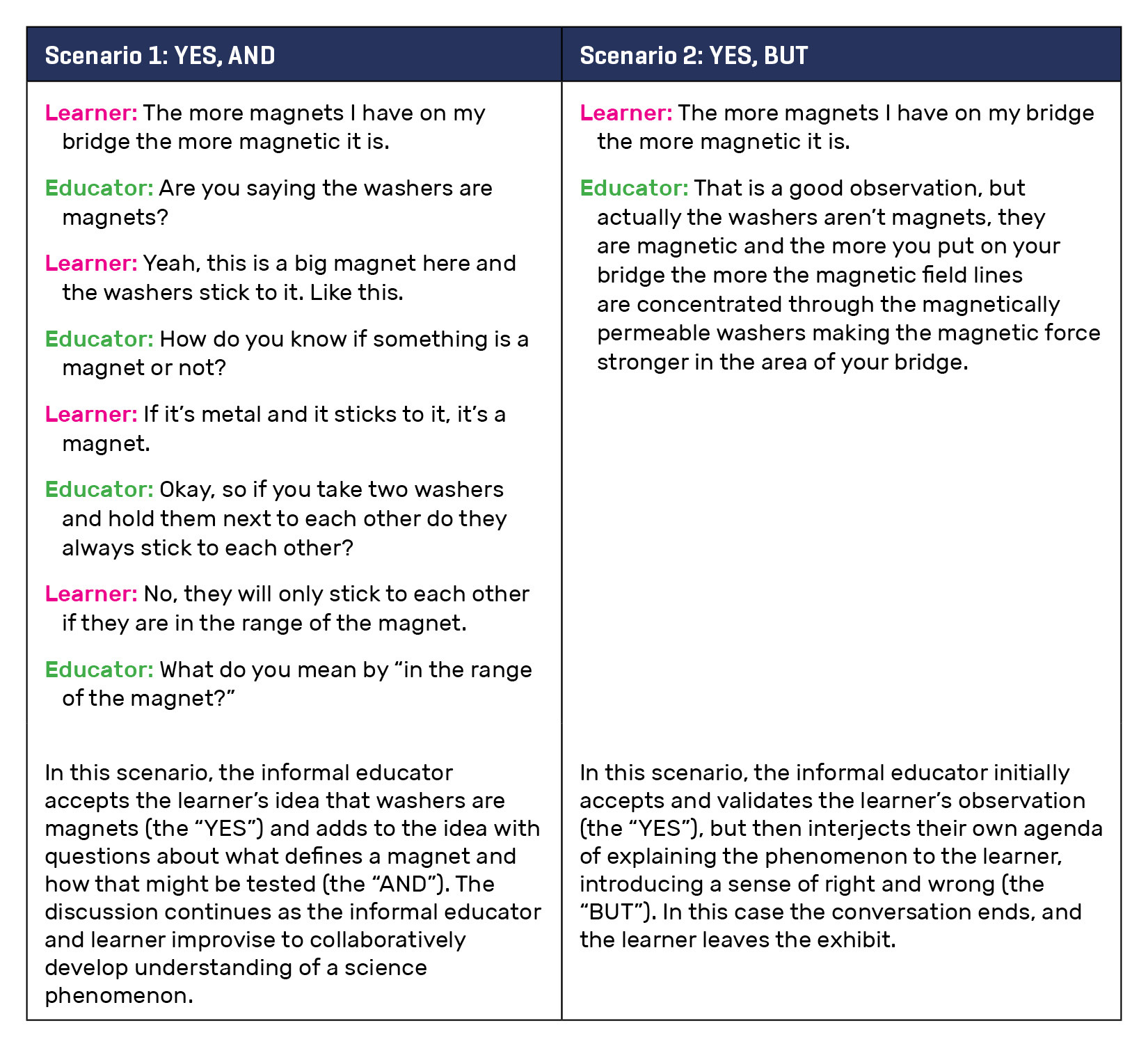
Applied improvisation players progress at different speeds and respond with different amounts of love or fear of different games. Players become more present and demonstrate increased listening and more spontaneity with decreased response latencies. The players’ use of gestures and whole-body communication increases, and their comfort with rapid changes in scenes becomes more obvious. Players accept that they are in a safe space, and they relax, have fun, and make progress in communicating with each other, joyfully accepting offers and building on fellow players’ ideas while growing as flexible and responsive educators.
Connections Between Applied Improvisation and Learner-Centered Facilitation
Over the past four years, MOXI has hosted four cohorts of participants in a yearlong training program about facilitating informal STEM learning. Participants in each cohort completed four quarters of university courses and worked over 800 paid hours as informal educators on the museum floor. At the beginning of each cohort, participants completed 10 hours of applied improvisation training led by our partnered professional applied improvisation instructor. Using feedback from the participants and MOXI and UCSB partners, the instructor revised the applied improvisation training curriculum to meet the needs of the informal learning space. He created a resource (see link below in resource section) to help other applied improvisation instructors meet the training needs of educators. To date, 34 program graduates have engaged over 400,000 museum visitors of all ages in STEM learning. They have worked with over 50,000 K–12 students during museum field trips and outreach at schools, modeling applied improvisation-informed learner-centered facilitation for their teachers.
Throughout MOXI's yearlong training program, all participants wrote weekly reflections on a wide variety of topics related to their studies and experience facilitating informal STEM learning with museum visitors. We also conducted hourlong interviews with 16 of the participants in the beginning, middle, and end of the program in which we asked them about the strategies that guided their day-to-day interactions with visitors and asked them to describe a good interaction with a museum visitor. In both the writings and interviews, many participants connected applied improvisation training to their facilitation. Here we provide five excerpts selected from the interviews and written reflections to demonstrate a variety of ways in which participants connected applied improvisation training to their facilitation. These include approaching facilitation with an open mind, listening to the learner and letting them direct the interaction, keeping a positive demeanor and paying attention to non-verbal cues, supporting the learner's self-efficacy by adding to their ideas, and being cognizant of not pre-planning interactions.
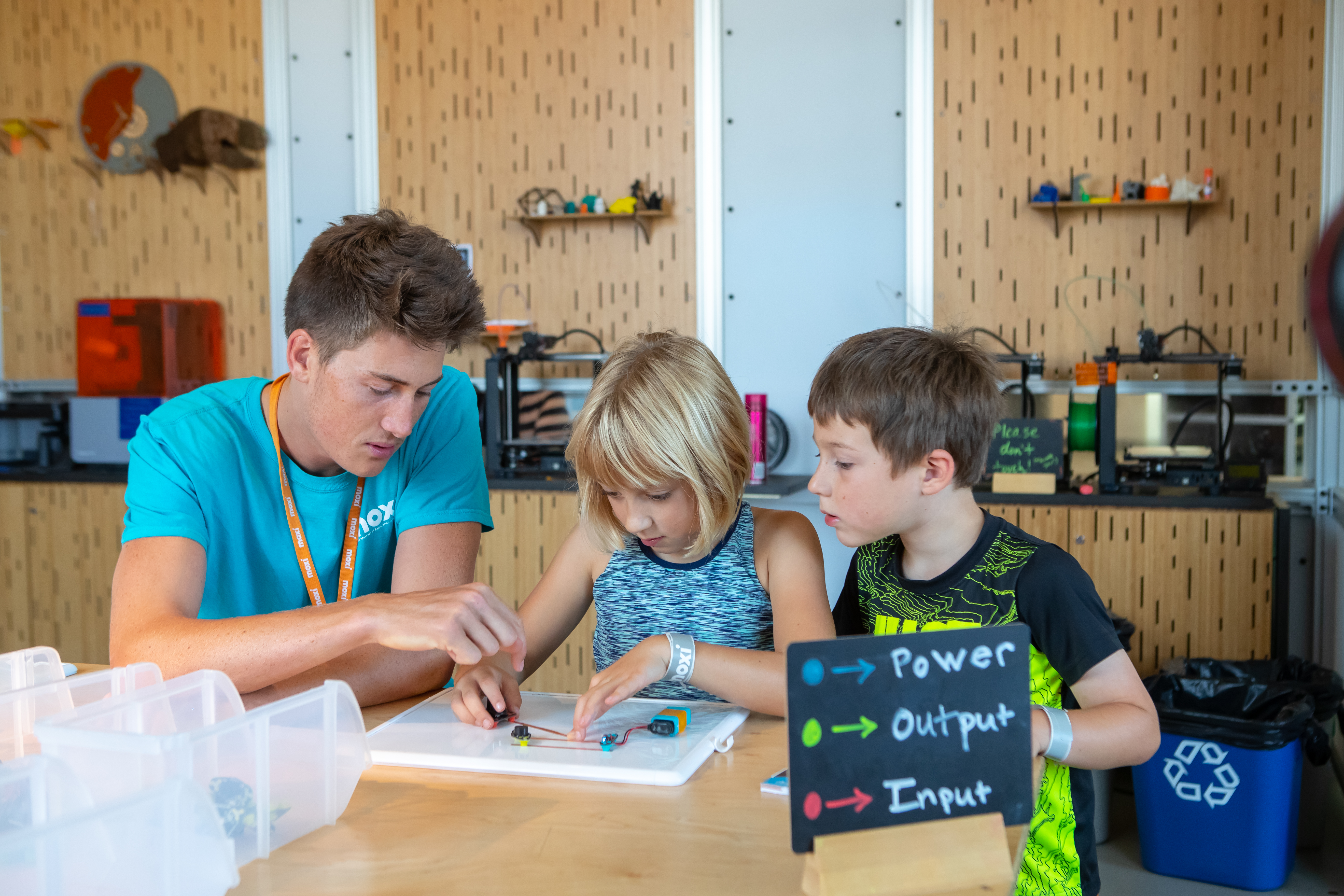
Steve
One week after completing the improvisation training, Steve (pseudonyms used for all training program participants), a participant with a master's degree in education and classroom teaching experience, wrote:
What I’ve learned from improv is to prepare to be unprepared. It’s so hard to approach a situation without expectations of where it’s supposed to go. It’s helpful for me to remember this as I approach visitors so that I can react purely to whatever they’re laying down.
He added,
I’ve been doing my best to enact this with visitors. Providing an enthusiastic affirmation of their energy (sometimes it’s not even verbal) and extending with whatever I’ve got in the moment...The more 'YES, AND-ing' I do, the more unexpected places learning can go.
Applied improvisation training gave Steve the skills needed to approach facilitation with an open mind and listen to the visitor to direct the interaction. Additionally, it reminded him to keep a positive demeanor and pay attention to non-verbal cues.
Maria
Seven weeks after completing the training, Maria, a participant with a teaching credential and prior classroom teaching experience, wrote:
I think the most beneficial part of improv for me was that it reinforces the idea that we don't have to know every answer in order to facilitate effectively. The practice of not anticipating what is coming next can be really difficult and I definitely struggled with that, however, when you get the hang of it, I think it becomes extremely valuable in any educational setting.
While Maria struggled with the unpredictable nature of improvisation, she benefited from the idea that effective facilitation does not require an educator to always have the answer.
Anne
Anne, a participant with a master’s degree in environmental management, observed an elementary school student’s idea during a field trip program in which students designed and tested a vehicle that would carry a penny and hover in the MOXI Wind Columns exhibit:
One girl decided that her contraption would contain not one, but three parachutes attached to the penny. While I knew from my own past experiences that even just one parachute will usually cause the contraption to completely fly out of the wind column, I wanted to give her the opportunity to plan her design and build it so that she could figure out on her own whether or not it would work. When she finally built it and got the chance to test it, she found that it flew straight out of the wind column. This was a much more valuable learning experience for her compared to if I were to tell her that usually parachutes will fly out of the wind column.
[This] reminded me of something that Dan [applied improvisation instructor] frequently brings up in our improv classes. He says that as children, we grow up being taught that there is always one right answer...We are trained to be uncreative, which is why some of the games that we play in improv class that require creativity are so difficult for us as adults. This is why it is so important to encourage wonderful ideas that children have so that they can continue to learn and be creative.
In this example Anne refrained from interjecting her own idea, allowing the student to test her idea and draw her own conclusion, thus supporting the student’s self-efficacy and engagement in science and engineering practices.
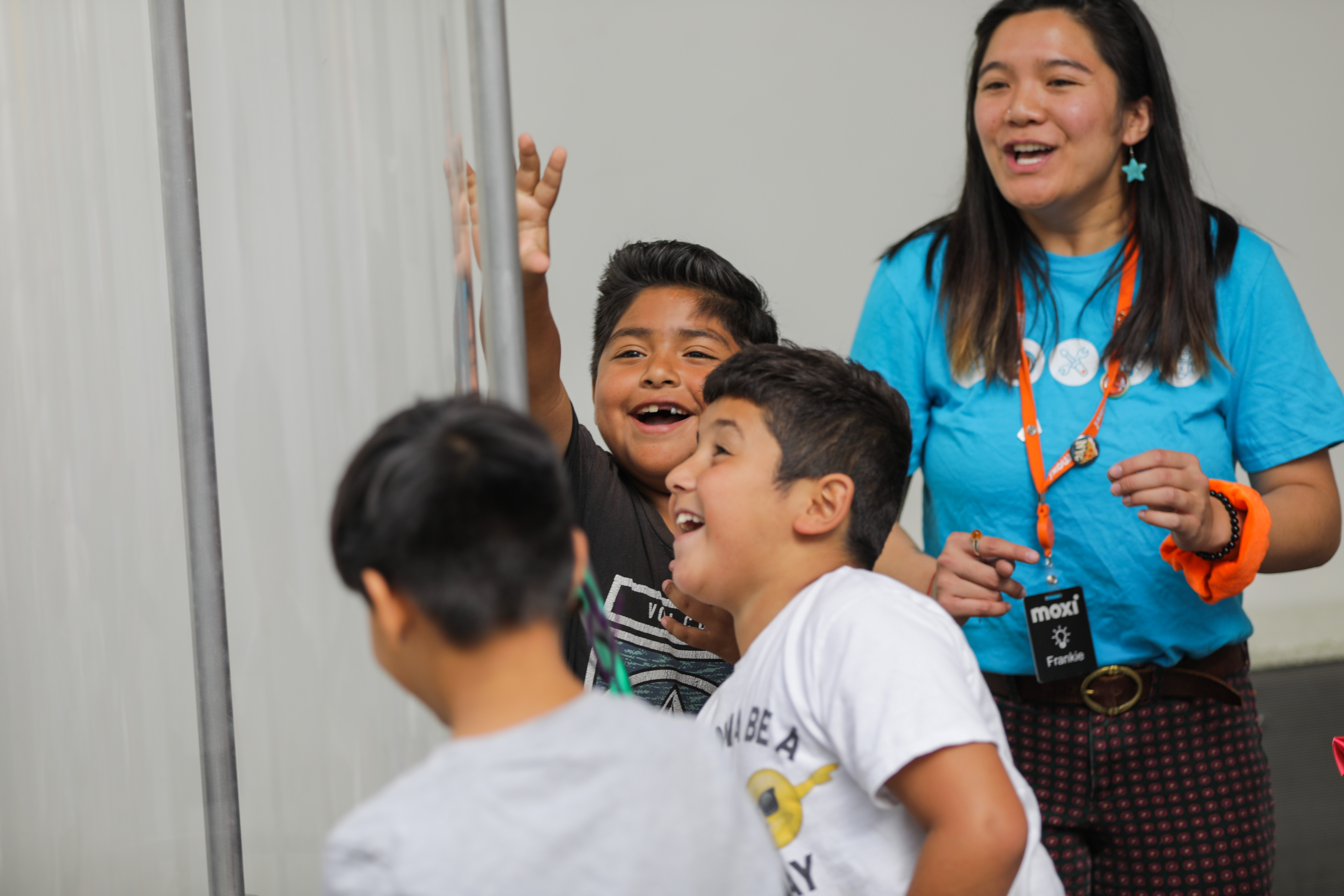
Terry
Terry, a participant with a master's degree in Earth science, recognized that using applied improvisation techniques in his facilitation helped increase the agency and self-efficacy of the learner:
The 'YES, AND' approach from improv allows the teacher to accept what the learner has come up with and build towards understanding the process, rather than shutting down their 'offer' and creating a new narrative. The latter action does not serve to encourage the learner to trust their own ability to learn - rather, it discourages them from taking risks or believing they can arrive at the correct answer. The conditions of positivity and acceptance inherent to improv are the same crucial aspects that encourage learners to pursue their thought process beyond that first guess and feel that they have a role equal to or greater than the teacher in their learning.
He then provided an example of a productive learner-centered interaction with an elementary school student at Build it, Test it, Race it [a MOXI race track exhibit where visitors build and race cars using a selection of pre-fabricated parts]:
I asked [the child] why he thought the longer car was beating shorter cars. Rather than offering that the car's weight or length helped, he thought for a moment, then suggested that the flexing between the car's multiple segments would help increase its speed. This answer was novel and surprising, and instead of leading to a typical conversation about the weight of the car and gravity, we talked about the curvature of the track, and how that might affect the car's speed...This interaction left him curious and confident in his ability to investigate the science and process at hand, whereas a negative answer on my part may have had a discouraging effect.
In this example Terry recognized that a “YES, BUT” response might have shut down the interaction, but a “YES, AND” response led to a fruitful and prolonged interaction, supporting the learner's self-efficacy.
Miguel
After completing three quarters of coursework on a variety of informal STEM learning topics and accumulating almost 400 hours of experience on the museum floor, Miguel, a participant with a bachelor’s degree in history of art and architecture, maintained the connection between his facilitation and what he learned in the 10 hours of applied improvisation training in the beginning of the yearlong program:
The first thing I think about when facilitating is not to come to a visitor with a specific goal in mind. Although it can be the hardest part, I make a mental point to try to meet the visitors where they are. Thanks to improv class.
More than nine months after applied improvisation training, Miguel continued to be cognizant of not pre-planning his interactions, but instead listening and responding to the learner.
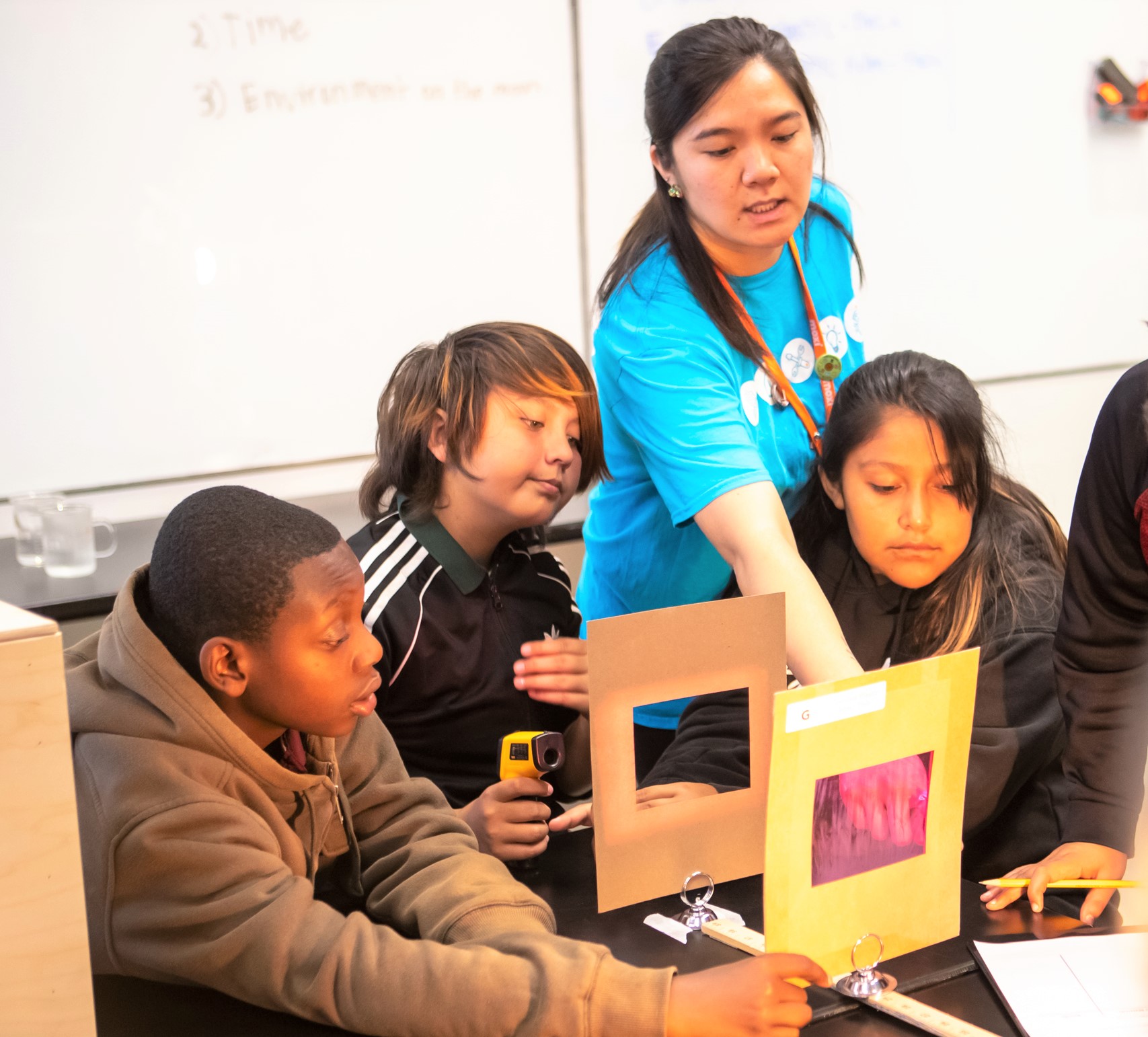
A MOXI educator engages fifth-grade students in an engineering design challenge to create a repair patch for a hypothetical lunar greenhouse.
These examples demonstrate a variety of ways in which participants connected applied improvisation training to their facilitation both immediately after the training and throughout their year in the facilitation training program. Several participants who came to informal STEM education with backgrounds as K–12 teachers also recognized the value of applied improvisation training across informal and formal educational settings.
Integrating Applied Improvisation Into Professional Development Programs
What follows are takeaways from our experience working with informal educators that can be applied by others starting to implement applied improvisation as part of professional development for new or experienced educators in formal or informal settings.
Partner with a professional
We recommend that institutions hire a professional applied improvisation instructor as this work is far richer in the hands of an experienced instructor. Although the exercises appear simple, using them to maximum effect in a fun, inviting environment requires significant experience. A trained professional is equipped to respond appropriately to diverse learners and the complex issues they might bring to the improvisation environment and can create an inclusive environment for participants.
Applied improvisation instructors can be found in your community through improvisation schools, improv organizations (e.g., Second City), comedy clubs, and theater groups. Local university theater departments often offer improv courses and have student improv clubs. The Applied Improvisation Network can help connect you with applied improvisation professionals worldwide.
Consider training logistics
Our training offered 10 hours of applied improvisation instruction over five weeks (two-hour sessions) as an introductory course, with average class sizes of 10 people. Ten hours of instruction was adequate for skills development and two-hour classes did not exceed participants’ attention span. Spreading the training over five weeks allowed participants time to sit with some of the concepts between classes, which was important for long-term skills development. Over time, applied improvisation can benefit all of a participant’s interactions with others, both at work and in life outside of the professional context, but to expect this outcome overnight is unrealistic.
Ten hours of training over five weeks cost our institution $100 per person—well worth it for a staff of informal educators who could listen carefully, observe gestures, expressions, and body language, and use these observations to make choices about how to facilitate learner-centered interactions. Post-training, our staff regularly found opportunities to play improv games to continue to improve communication skills, remind facilitators to listen and observe more than they respond, and build trust and teamwork among educators.
Create a safe space
It was not uncommon for participants in our training program to wonder why “improv” was on the schedule. Participants may feel uncomfortable with this type of training, and it is important to communicate the expectations for and benefits from participating. Applied improvisation requires a high level of trust among participants. It is important they understand that applied improvisation is not about being funny or witty and they will not be trained to be improv comedians, but rather it is intended to expand their tool belt when interacting with learners and building upon their ideas. Freeing the work from its association with comedy is essential in reducing the fear and attendant stage fright or performance anxiety that some educators might experience.
Finally, while language diversity is often a benefit in learning environments, the verbal games of applied improvisation can present a challenge for non-native speakers or people with language disabilities. It is important to ensure that an applied improvisation instructor assesses the verbal skills of participants during the early classes before incorporating games based on those same skills. Again, a professional applied improvisation instructor will be best suited to adjust the curriculum to make accommodations for varying levels of verbal skills.
Conclusion
Applied improvisation training consists of fun, playful exercises in group communication in which participants collaboratively create dialog by being present, listening and observing carefully, and saying YES to what they are given AND adding to it. It improves skills of being present and listening; adapting to different situations, being spontaneous in interactions; adding to the ideas of others; reading the gestures, expressions, and body motion of others; and using gestures, expressions, and body motion to communicate. Applied improvisation training can help prepare the next generation of STEM educators in both formal and informal settings to facilitate STEM learning in a way that ensures all learners thrive.
Resources
- Notes for the Applied Improv Instructor: Suggestions for a professional applied improvisation instructor hired to teach applied improvisation to educators
Acknowledgment
This material is based upon work supported by the National Science Foundation under grants DRL-1906320 and DRL-1906322. Any opinions, findings, and conclusions or recommendations expressed in this material are those of the authors and do not necessarily reflect the views of the National Science Foundation.
Ron Skinner (ron.skinner@moxi.org) is a research & evaluation specialist at MOXI, The Wolf Museum of Exploration + Innovation; Danielle Boyd Harlow is a professor at the University of California Santa Barbara Gevirtz Graduate School of Education; Dan Gunther is a professional actor and theater instructor at Improv Studio Santa Barbara; Kaia-Joye Wesolowski is a director of learning experiences at MOXI, The Wolf Museum of Exploration + Innovation; Jasmine Marckwordt is a graduate of the University of California Santa Barbara Gevirtz Graduate School of Education; and Alexandria Muller is a graduate student at the University of California Santa Barbara Gevirtz Graduate School of Education, all in Santa Barbara, California.
citation: Skinner, R., D. Harlow, D. Gunther, K.J. Wesolowski, J. Marckwordt, and A. Muller. 2022. Facilitating learner-centered interactions through applied improvisation. Connected Science Learning 4 (3). https://www.nsta.org/connected-science-learning/connected-science-learning-may-june-2022/facilitating-learner-centered
Professional Learning Science and Engineering Practices STEM Teaching Strategies Informal Education


